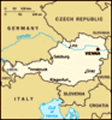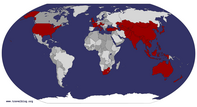Advertisement
Thursday 4-28 to Saturday 4-30
Vienna is another beautiful city with a mix of art nouveau and Renaissance-style buildings. And we seem to have arrived here during European high season – there are tons of European tourists everywhere! (In fact in most of Europe so far, we really haven’t run into too many American. Not surprising, considering how low the dollar is right now.) We visited St. Stephen’s Cathedral – a monstrous Gothic structure smack dab in the middle of the city and surrounded by what looks like the Viennese version of Rodeo Drive (an incredibly opulent street that has a huge gilded fountain for a fire hydrant). We got our first lesson on how important classical music is to the history and culture of Vienna at St. Stephen’s: this is where Mozart was married and where his funeral was held. In addition, it houses one of the most interesting religious icons I’ve come across so far: an icon of the Virgin Mary that is reported to have shed real tears. Sadly it did not perform for us, as no one has seen it shed tears in over 300 years. [Nick Note: Apparently the figure shed tears in another town so
the rulers at the time brought it to Vienna, stolen fair and square. However it never shed another tear and the town that they took it from requested it back. Eventually the town was given back a copy and apparently that copy is now shedding tears in the original town. Yeah I’m a little skeptical.]
Most of our time in Vienna was spent exploring the old palaces. Our first was the Hofburg Imperial Palace – seat of the Holy Roman Empire for centuries (once again, my ignorance of history shone through, as I had no idea Vienna had been the seat of Catholic power since the 13th century) and winter residence of the famous Habsburg dynasty. We ended up spending nearly 3 hours just walking through the vast treasury of the palace, taking in all the vestments, crown jewels and religious relics. Interestingly enough, there were many such relics and historical artifacts (like Jesus’ loin cloth, a piece of the holy cross, a large agate bowl said to be the holy grail and even Charlemagne’s sword) that were subsequently proven to be not to be so (surprise, surprise). [Nick Note: That is why it is better, like the Muslim
holy relics in Istanbul, never to let experts test the claim as most of the time it is easily proven that these relics are fakes. However I think Charlemagne’s sword was actually his. Some of the items, like a shroud that supposedly covered Jesus after death, were proven to be almost a millennia younger than needed. Besides religious items the most prized possessions were unicorn horns, which today we know are narwhal tusks. It makes you wonder if the Holy Roman emperors were tricking others and knew that the tusks were from a type of whale or I the Vikings and others were getting these tasks and then tricking the Holy Roman emperors to pay a lot of money telling them they cam from unicorns. In the museum a unicorn was describes as a small, horse-like animal with incredible strength and impossible to kill or capture… how convenient.] They even had artifacts from Napoleon II’s nursery (Napoleon’s second wife was a Hapsburg), like his baptism chalice, dresses and basinet. When we finally walked out of the treasury, a little dazed and blurry eyed, we were delighted in the number of beautiful public parks that Vienna has. It was a beautiful
sunny day; so we strolled around the Volksgarten and grabbed a hot dog (read: giant Viennese sausage in a baguette) before picnicking on the grass in the Burggarten like the many other locals enjoying he nice weather. After taking a peak at the royal stables, we tried to go see a movie but learned a little too late that all movies here are dubbed in German – at least we were able to get our money back ($36 for 2 people!). So we went home and spent the rest of the evening trying to find something on English-speaking tv that wasn’t coverage of the UK royal wedding. As you can imagine, we did not succeed.
Next day we visited Schonbrunn Palace (the Habsburg summer retreat), where we saw more of the state apartments and how the royals lived over the last few centuries. This is where Marie Antoinette grew up before being married off to France and where I learned a lot about the strong female Habsburgs, like Empress Elisabeth (aka Sisi) and Empress Maria Theresa who had as much influence, if not more, on the empire than their husbands did. The palace is also famous for its immense
gardens; nothing as extensive as Versailles (its contemporary counterpart), but nice to stroll around in. There’s even a small hedge maze, which we got lost in for a little while, and a playground, where we played in fun house mirrors and I made Nick sick by spinning him around on the carousel (sorry, Tico).
Our last palace was Belvedere Palace; the prince’s suburban entertainment villa back in the 17th century. Very simple and small compared to the other palaces we saw, the Belvedere has been turned into an art gallery that mostly exhibits some of Gustav Klimpt’s most famous works, including The Kiss and (my favorite) Judith I. I was also surprised to see there Jacques-Louis David’s iconic Napoleon at the Saint-Bernard Pass. I swear I’ve seen this painting before in Paris, but I must have been wrong; I suppose I’ve seen it so many times in art history and French classes that my brain had been tricked into thinking it had actually seen it in real life :o)
We also paid a visit to Naschmarkt – one of Vienna’s oldest and largest outdoor markets – where the food stands looked so good I could have eaten everything
in sight! My god, the pastries and breads here are soooooo tempting! Around the corner from the market was the Vienna Opera House, where we took a brief historic tour. Mahler actually conducted here and created huge reforms for opera audiences the world over by being the first to turn down the house lights and to stop serving any food or drinks during a performance – go figure). All but the exterior of the opera house was demolished in the bomb raids of WWII, so most of what we saw was not the original opera house, but we had such an enthusiastic and opera-knowledgeable tour guide that it was a really good experience, nonetheless. Our guide even gave us tips for getting last minute standing-room-only seats for the performances. So we ended up going to see Mozart’s Don Giovanni, but didn’t fully realize what we were getting ourselves into! We got in line early (2 hours) to get tickets (only 4 Euros for 1st row center 1st floor balcony! Woo hoo!), but then learned that we also had to wait in line for our spots (it was a poor way to disperse tickets, it would have been much better if
the spots were numbered and were assigned after the 1st line when you get tickets). Fortunately, Nick and I made it to the front of the seats and had just enough time to run out and grab a dinner of street vendor hot dogs (I have never eaten a giant sausage so fast, I was not feeling well afterwards) before the show started. Unfortunately, it was not that good of a show; in fact, it was down right terrible! We chucked up the entire 7 hours (from the time we got in line to the time the show ended) to the opportunity to see an opera by Mozart performed live in the Vienna Opera House. I wish it could have been as good as it sounds but the art direction was downright horrible! They couldn’t seem to decide on a time period (costumes and set design ranged from the 16th to 18th centuries, to the 1930s and 1970s) and the plot was just plain awful. Mozart was a brilliant composer but doesn’t really seem to have been a good storyteller. Sadly, Don Giovanni sucked; oh well. [Nick Note: I have to admit, by today’s standards the story of Don Giovanni
would be considered laughably bad. Maybe a 20% on the TomatoMeter.]
Unfortunately, Vienna seemed to have a lot of little “down points,” which we weren’t expecting. Don’t get me wrong, it was a beautiful city but we were disappointed by the opera and the cost of food was really high. We had no idea Vienna would be more expensive than Rome of all places! A small drink at Starbucks was $6 and the average Viennese meal cost us $45 – just for lunch! No more schnitzel and goulash for us – we quickly learned where to find the Subway and a cheap Vietnamese restaurants. So when all the stores closed down around 5-6pm (what do the Viennese do at night if everything’s closed?!), we would just grab some take out and head back to the hotel to catch up on some American tv, which for us was actually a pretty nice way to end the evening ;o)
Advertisement
Tot: 0.149s; Tpl: 0.01s; cc: 17; qc: 54; dbt: 0.045s; 1; m:domysql w:travelblog (10.17.0.13); sld: 1;
; mem: 1.2mb











